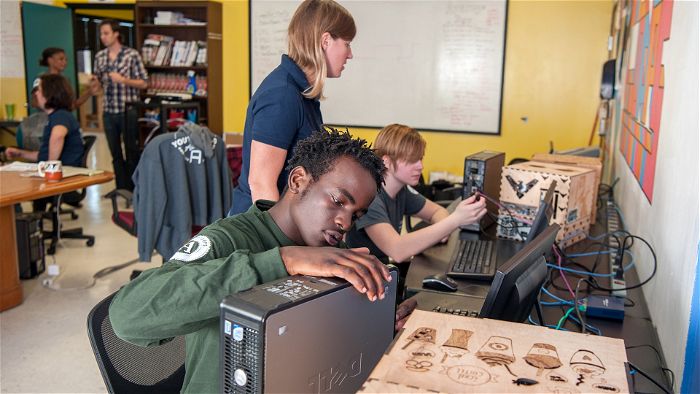Apprenticeship is a proven workforce training model that has offered people pathways to quality jobs for generations. Traditionally associated with the skilled trades, apprenticeship in recent years has expanded into new sectors, including health care, IT, advanced manufacturing, and finance, as workers and employers throughout the economy have come to appreciate the unique value of its combination of paid hands-on training and classroom instruction.
At Jobs for the Future (JFF), we’re working diligently to reimagine work-based learning, and we support efforts to expand apprenticeship further. And as we celebrate the inaugural Youth Apprenticeship Week, we’re emphasizing the need to create more apprenticeship opportunities for young people, especially those between the ages of 16 and 24 who aren’t in school and aren’t working.
Unlike apprenticeship systems in other parts of the world, the U.S. apprenticeship system wasn’t built as a career pathway for young people. The average age of new participants in a U.S. Registered Apprenticeship (RA) is 29. And according to the U.S. Department of Labor’s Employment and Training Administration (ETA), 62% of active participants in U.S. RA programs were over the age of 24 in 2021 (the most recent year for which data is available).
However, the federal government and other stakeholders are investing significant amounts of time, money, and other resources into efforts to make apprenticeship a viable pathway to postsecondary education and career advancement for young people.
For example, the ETA has allocated over $7 million to the Youth Apprenticeship Intermediaries initiative, which has established more than 175 youth-focused apprenticeship programs over the past five years and created opportunities for the more than 5,700 young people who have entered an apprenticeship program during that time. The ETA has also awarded 39 recipients a total of $171 million in Apprenticeship Building America grants to support efforts to strengthen and modernize Registered Apprenticeship programs as a way to give workers, particularly young people, reliable pathways to economic advancement.
In addition, JFF and eight other organizations in the Partnership to Advance Youth Apprenticeship have been working together since 2020 to ensure that high-quality apprenticeships are accessible to high-school-age youth nationwide.
A Promising Start, But There’s Still Work to Do
With such robust supports in place, the likelihood that young people across the country will have opportunities to achieve success through apprenticeship is steadily increasing.
However, there’s still work to be done, particularly for young people aged 16 to 24 who aren’t in school and aren’t working—a population sometimes known as opportunity youth. In the United States, more than 5 million young people fit that description, and 41% of them are from households with low incomes, 15% have a disability (compared with 5% of young people who are in school or working), and nearly 60% are individuals who identify as Black, Latine, or Indigenous.
Apprenticeship can be a real game-changer for the young people in this category, offering an engaging way to reconnect with work and learning and get on pathways to career success. With structured on-the-job training, classroom instruction, mentoring, and support services, apprenticeships enable these individuals to not only develop in-demand skills required for jobs that can lead to economic advancement but also build the confidence they need to succeed throughout their lives.
However, for these opportunities to truly make a difference for young people who are disconnected from work and learning, apprenticeship employers and program sponsors must be aware of the unique needs of people in this population and offer them personalized attention and support. Setting up an apprenticeship is just the first step. To ensure that participants come out of the program ready to move into well-paid jobs and prepared to take on future opportunities, program providers must make sure that each individual has the resources and guidance they need to fully engage in work and learning activities, persist in the program, and complete it successfully.
A Personalized Approach Unlocks Potential
At JFF, we’ve learned that a personalized approach can truly unlock the potential of apprenticeships for young people who haven’t been engaged in work or learning for extended periods of time.
In 2019, with financial backing from the U.S. Department of Labor’s Apprenticeship Expansion and Modernization Fund, JFF’s Center for Apprenticeship & Work-Based Learning launched a three-year effort to identify ways to increase access to apprenticeship for young people who could be described as opportunity youth. Working with 15 organizations nationwide, we uncovered four factors that play pivotal roles in ensuring that these young people can successfully access, participate in, and complete apprenticeships:
- Participation in high-quality pre-apprenticeship programs helps break down barriers and pave the way for success.
- The perspectives and needs of youth who have faced barriers to employment and education must be placed at the forefront of program design.
- Flexible funding models and the availability of wraparound supports are critical to ensuring that all participants have access to services like child care, transportation, and emergency financial assistance so they can fully participate in an apprenticeship.
- Partnerships with youth-serving community programs, workforce boards, school districts, and other organizations are essential, especially to the success of recruitment efforts.
JFF’s Apprenticeship and Expansion Modernization Fund project revealed that these approaches can help program providers reach young people and put them on pathways to well-paid jobs. The table below compares the ages, gender breakdown, and wages of the participants in the JFF project—more than 700 young people in 62 different occupations at 234 employers—with national averages:




